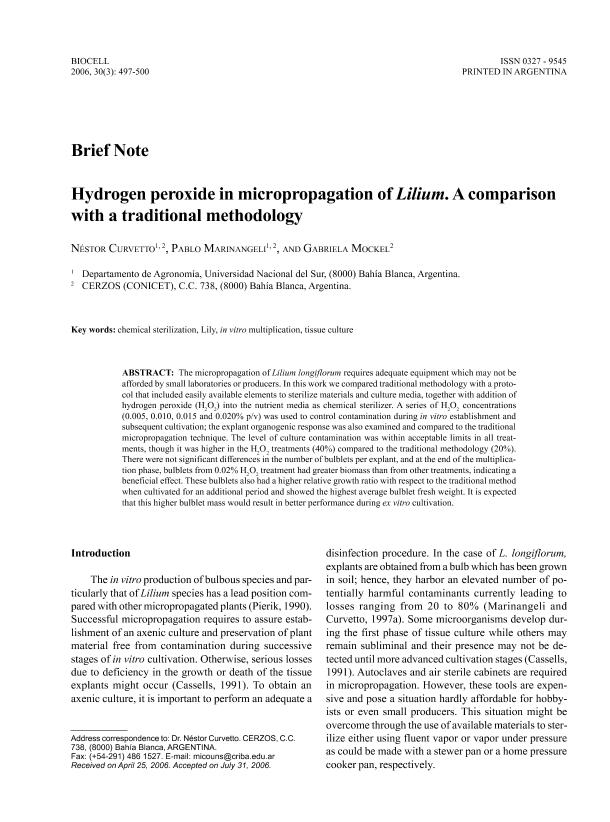Mostrar el registro sencillo del ítem
dc.contributor.author
Curvetto, Nestor Raul

dc.contributor.author
Marinangeli, Pablo Alejandro

dc.contributor.author
Mockel, Gabriela Carolina

dc.date.available
2017-12-13T17:32:44Z
dc.date.issued
2006-12
dc.identifier.citation
Curvetto, Nestor Raul; Marinangeli, Pablo Alejandro; Mockel, Gabriela Carolina; Hydrogen peroxide in micropropagation of Lilium: A comparison with a traditional methodology; Instituto de Histología y Embriología; Biocell; 30; 3; 12-2006; 497-500
dc.identifier.issn
0327-9545
dc.identifier.uri
http://hdl.handle.net/11336/30466
dc.description.abstract
The micropropagation of Lilium longiflorum requires adequate equipment which may not be afforded by small laboratories or producers. In this work we compared traditional methodology with a protocol that included easily available elements to sterilize materials and culture media, together with addition of hydrogen peroxide (H2O2) into the nutrient media as chemical sterilizer. A series of H2O2 concentrations (0.005, 0.010, 0.015 and 0.020% p/v) was used to control contamination during in vitro establishment and subsequent cultivation; the explant organogenic response was also examined and compared to the traditional micropropagation technique. The level of culture contamination was within acceptable limits in all treatments, though it was higher in the H2O2 treatments (40%) compared to the traditional methodology (20%). There were not significant differences in the number of bulblets per explant, and at the end of the multiplication phase, bulblets from 0.02% H2O2 treatment had greater biomass than from other treatments, indicating a beneficial effect. These bulblets also had a higher relative growth ratio with respect to the traditional method when cultivated for an additional period and showed the highest average bulblet fresh weight. It is expected that this higher bulblet mass would result in better performance during ex vitro cultivation.
dc.format
application/pdf
dc.language.iso
eng
dc.publisher
Instituto de Histología y Embriología

dc.rights
info:eu-repo/semantics/openAccess
dc.rights.uri
https://creativecommons.org/licenses/by-nc-sa/2.5/ar/
dc.subject
Chemical Sterilization
dc.subject
Lily
dc.subject
In Vitro Multiplication
dc.subject
Tissue Culture
dc.subject.classification
Otras Biotecnología Agropecuaria

dc.subject.classification
Biotecnología Agropecuaria

dc.subject.classification
CIENCIAS AGRÍCOLAS

dc.title
Hydrogen peroxide in micropropagation of Lilium: A comparison with a traditional methodology
dc.type
info:eu-repo/semantics/article
dc.type
info:ar-repo/semantics/artículo
dc.type
info:eu-repo/semantics/publishedVersion
dc.date.updated
2017-11-03T19:55:16Z
dc.identifier.eissn
1667-5746
dc.journal.volume
30
dc.journal.number
3
dc.journal.pagination
497-500
dc.journal.pais
Argentina

dc.journal.ciudad
Mendoza
dc.description.fil
Fil: Curvetto, Nestor Raul. Consejo Nacional de Investigaciones Científicas y Técnicas. Centro Científico Tecnológico Conicet - Bahía Blanca. Centro de Recursos Naturales Renovables de la Zona Semiárida. Universidad Nacional del Sur. Centro de Recursos Naturales Renovables de la Zona Semiárida; Argentina
dc.description.fil
Fil: Marinangeli, Pablo Alejandro. Consejo Nacional de Investigaciones Científicas y Técnicas. Centro Científico Tecnológico Conicet - Bahía Blanca. Centro de Recursos Naturales Renovables de la Zona Semiárida. Universidad Nacional del Sur. Centro de Recursos Naturales Renovables de la Zona Semiárida; Argentina
dc.description.fil
Fil: Mockel, Gabriela Carolina. Consejo Nacional de Investigaciones Científicas y Técnicas. Centro Científico Tecnológico Conicet - Bahía Blanca. Centro de Recursos Naturales Renovables de la Zona Semiárida. Universidad Nacional del Sur. Centro de Recursos Naturales Renovables de la Zona Semiárida; Argentina
dc.journal.title
Biocell

dc.relation.alternativeid
info:eu-repo/semantics/altIdentifier/url/http://ref.scielo.org/kcwqg6
Archivos asociados
